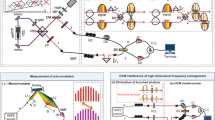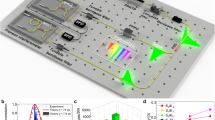Abstract
Quantum entanglement is a fundamental resource for secure information processing and communications, and hyperentanglement or high-dimensional entanglement has been separately proposed for its high data capacity and error resilience. The continuous-variable nature of the energy–time entanglement makes it an ideal candidate for efficient high-dimensional coding with minimal limitations. Here, we demonstrate the first simultaneous high-dimensional hyperentanglement using a biphoton frequency comb to harness the full potential in both the energy and time domain. Long-postulated Hong–Ou–Mandel quantum revival is exhibited, with up to 19 time-bins and 96.5% visibilities. We further witness the high-dimensional energy–time entanglement through Franson revivals, observed periodically at integer time-bins, with 97.8% visibility. This qudit state is observed to simultaneously violate the generalized Bell inequality by up to 10.95 standard deviations while observing recurrent Clauser–Horne–Shimony–Holt S-parameters up to 2.76. Our biphoton frequency comb provides a platform for photon-efficient quantum communications towards the ultimate channel capacity through energy–time–polarization high-dimensional encoding.
This is a preview of subscription content, access via your institution
Access options
Subscribe to this journal
Receive 12 print issues and online access
$209.00 per year
only $17.42 per issue
Buy this article
- Purchase on Springer Link
- Instant access to full article PDF
Prices may be subject to local taxes which are calculated during checkout





Similar content being viewed by others
References
Dada, A. C., Leach, J., Buller, G. S., Padgett, M. J. & Andersson, E. Experimental high-dimensional two-photon entanglement and violations of generalized Bell inequalities. Nature Phys. 7, 677–680 (2011).
Barreiro, J. T., Wei, T. C. & Kwiat, P. G. Beating the channel capacity of linear photonic superdense coding. Nature Phys. 4, 282–286 (2008).
Menicucci, N. C., Flammia, S. T. & Pfister, O. One-way quantum computing in the optical frequency comb. Phys. Rev. Lett. 101, 130501 (2008).
Krenn, M. et al. Generation and confirmation of a (100 × 100)-dimensional entangled quantum system. Proc. Natl Acad. Sci. USA 111, 6243–6247 (2014).
Strobel, H. et al. Fisher information and entanglement of non-Gaussian spin states. Science 345, 424–427 (2014).
Howland, G. A. & Howell, J. C. Efficient high-dimensional entanglement imaging with a compressive-sensing double-pixel camera. Phys. Rev. X 3, 011013 (2013).
Bao, W.-B. et al. Experimental demonstration of a hyper-entangled ten-qubit Schrödinger cat state. Nature Phys. 6, 331–335 (2010).
Sun, F. W. et al. Experimental demonstration of phase measurement precision beating standard quantum limit by projection measurement. Europhys. Lett. 82, 24001 (2008).
Badziag, P., Brukner, C., Laskowski, W., Pterek, T. & Zukowski, M. Experimentally friendly geometrical criteria for entanglement. Phys. Rev. Lett. 100, 140403 (2008).
Fickler, R. et al. Quantum entanglement of high angular momenta. Science 338, 640–643 (2012).
Fickler, R. et al. Interface between path and orbital angular momentum entanglement for high-dimensional photonic quantum information. Nature Commun. 5, 4502 (2014).
Leach, J. et al. Quantum correlations in optical angle–orbital angular momentum variables. Science 329, 662–665 (2010).
Peruzzo, A. et al. Quantum walks of correlated photons. Science 329, 1500–1503 (2010).
Edgar, M. P. et al. Imaging high-dimensional spatial entanglement with a camera. Nature Commun. 3, 984 (2012).
Dixon, P. B., Howland, G. A., Schneeloch, J. & Howell, J. C. Quantum mutual information capacity for high-dimensional entangled states. Phys. Rev. Lett. 108, 143603 (2012).
Franson, J. D. Bell inequality for position and time. Phys. Rev. Lett. 62, 2205–2208 (1989).
Shalm, L. K. et al. Three-photon energy–time entanglement. Nature Phys. 9, 19–22 (2013).
Cuevas, A. et al. Long-distance distribution of genuine energy–time entanglement. Nature Commun. 4, 2871 (2013).
Thew, R. T., Acin, A., Zbinden, H. & Gisin, N. Bell-type test of energy–time entangled qutrits. Phys. Rev. Lett. 93, 010503 (2004).
Lloyd, S., Shapiro, J. H. & Wong, F. N. C. Quantum magic bullets by means of entanglement. J. Opt. Soc. Am. B 19, 312–318 (2002).
Ali-Khan, I., Broadbent, C. J. & Howell, J. C. Large-alphabet quantum key distribution using energy–time entangled bipartite states. Phys. Rev. Lett. 98, 060503 (2007).
Zhong, T. et al. Photon-efficient quantum key distribution using time–energy entanglement with high-dimensional encoding. New J. Phys. 17, 022002 (2015).
Takeda, S., Mizuta, T., Fuwa, M., van Loock, P. & Furusawa, A. Deterministic quantum teleportation of photonic quantum bits by a hybrid technique. Nature 500, 315–318 (2013).
Jayakumar, H. et al. Time-bin entangled photons from a quantum dot. Nature Commun. 5, 4251 (2014).
Marcikic, I. et al. Time-bin entangled qubits for quantum communication created by femtosecond pulses. Phys. Rev. A 66, 062308 (2002).
De Riedmatten, H. et al. Tailoring photonic entanglement in high-dimensional Hilbert spaces. Phys. Rev. A 69, 050304(R) (2004).
Roslund, J., de Araújo, R. M., Jiang, S., Fabre, C. & Treps, N. Wavelength-multiplexed quantum networks with ultrafast frequency combs. Nature Photon. 8, 109–112 (2014).
Pinel, O. et al. Generation and characterization of multimode quantum frequency combs. Phys. Rev. Lett. 108, 083601 (2012).
Lu, Y. J., Campbell, R. L. & Ou, Z. Y. Mode-locked two-photon states. Phys. Rev. Lett. 91, 163602 (2003).
Shapiro, J. H. Coincidence dips and revivals from a Type-II optical parametric amplifier. Technical Digest of Topical Conference on Nonlinear Optics, paper FC7-1, Maui, HI, 2002.
Hong, C. K., Ou, Z. Y. & Mandel, L. Measurement of subpicosecond time intervals between two photons by interference. Phys. Rev. Lett. 59, 2044–2046 (1987).
Zhong, T., Wong, F. N. C., Roberts, T. D. & Battle, P. High performance photon-pair source based on a fiber-coupled periodically poled KTiOPO4 waveguide. Opt. Express 17, 12019–12030 (2009).
Gisin, N. & Thew, R. Quantum communication. Nature Photon. 1, 165–171 (2007).
Restelli, A. & Bienfang, J. C. Avalanche discrimination and high-speed counting in periodically gated single-photon avalanche diodes. Proc. SPIE. 8375, 83750Z (2012).
Yuan, Z. L., Kardynal, B. E., Sharpe, A. W. & Shields, A. J. High speed single photon detection in the near infrared. Appl. Phys. Lett. 91, 041114 (2007).
Acknowledgements
The authors thank T. Pittman, J. Franson and D. Fields for assistance, and A. Kumar Vinod, Y. Li, J. Poekert, M. Itzler, P. Li, D.R. Englund and X. Hu for discussions. This work is supported by the InPho programme of the Defense Advanced Research Projects Agency (DARPA) under contract no. W911NF-10-1-0416. Y.X.G. is supported by the National Natural Science Foundations of China (grant no. 11474050).
Author information
Authors and Affiliations
Contributions
Z.X., T.Z., S.S., X.X. and J.L. performed the measurements. J.C.B. and A.R. developed the 1.3 GHz detectors. T.Z., Y.X.G., F.N.C.W. and J.H.S. provided the theory and samples. All authors helped with manuscript preparation.
Corresponding authors
Ethics declarations
Competing interests
The authors declare no competing financial interests.
Supplementary information
Supplementary information
Supplementary information (PDF 2619 kb)
Rights and permissions
About this article
Cite this article
Xie, Z., Zhong, T., Shrestha, S. et al. Harnessing high-dimensional hyperentanglement through a biphoton frequency comb. Nature Photon 9, 536–542 (2015). https://doi.org/10.1038/nphoton.2015.110
Received:
Accepted:
Published:
Issue Date:
DOI: https://doi.org/10.1038/nphoton.2015.110
This article is cited by
-
Integrated vortex soliton microcombs
Nature Photonics (2024)
-
Preparation of maximally-entangled states with multiple cat-state qutrits in circuit QED
Frontiers of Physics (2024)
-
Progress in quantum teleportation
Nature Reviews Physics (2023)
-
On-chip parallel processing of quantum frequency comb
npj Quantum Information (2023)
-
A chip-scale polarization-spatial-momentum quantum SWAP gate in silicon nanophotonics
Nature Photonics (2023)



